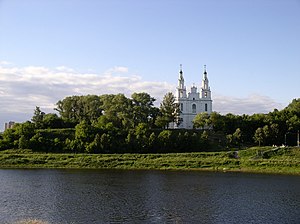Second battle at Polotsk
| date | October 18-20, 1812 |
|---|---|
| place | Polotsk |
| output | Russian victory |
| Parties to the conflict | |
|---|---|
| Commander | |
| Troop strength | |
| 23,000-27,000 | 49,000 |
| losses | |
|
8,000 |
8,000-12,000 |
Mir - Mogilev - Ostrovno - Kobrin - Klyastitsy - Gorodeczno - Smolensk - Polotsk I - Walutino - Borodino - Tschirikovo - Tarutino - Maloyaroslavets - Polotsk II - Vyazma - Lyachovo - Chaschniki - Smoljany - Krasnoi - Beresina
The Second Battle of Polotsk (October 18-20, 1812) took place during Napoleon's campaign to Russia .
At this meeting, Russian troops under General Wittgenstein attacked and defeated a French - Bavarian army division under the command of Laurent de Gouvion Saint-Cyr . As a result of this victory, the further operations of the French and their allies in Belarus were severely hampered and the foundation stone for victory in the Battle of the Berezina was laid.
background
During the advance on Moscow , Napoleon left a contingent of French and German troops on his northern flank to secure them against the Russian General Wittgenstein. The French defense corner at Polotsk, commanded by St. Cyr and Charles Nicolas Oudinot , was about 200 km east of the Polish border and about 150 km northwest of Smolensk . The position was extremely important to Napoleon for various reasons.
By creating a front at Polotsk, Napoleon tried to neutralize Wittgenstein's troops. It was important for the French that Wittgenstein not succeed in pushing south. Such an advance would have hit the Grande Armée , which was developing near Moscow for the main battle, in the rear, with disastrous consequences.
Such a development would have cut off the Grande Armée from its connections to Europe, and there was even a risk of encirclement.
Furthermore, the French positions at Polotsk were important for the protection of Vitebsk , one of the three main supply depots in the western part of Russia. These three main depots (plus Minsk and Smolensk ) were built to supply the Grande Armée should the campaign last longer than planned.
Throughout the summer and up to the early autumn of 1812, the French and Russian troops stood inactive at Polotsk, since St. Cyr was only concerned with keeping the Dvina Line. The aim of the moderately successful first battle at Polotsk in August 1812 was only to bind Wittgenstein's troops. Since this succeeded, it can be considered a victory for the French.
In mid-October the situation began to improve in favor of the Russians, as they received massive reinforcements, which meant that they were numerically superior to the French. At that time Wittgenstein had almost 50,000 men - 31,000 regular troops and 9,000 militiamen from Polotsk. Another 9,000 men under the command of General Fabian Gotthard von Steinheil operated rearward and on the flank of Polotsk.
St. Cyr had only 23,000 to 27,000 men to oppose this Russian superiority. On October 18, Wittgenstein opened combat operations against the French Dwina line.
The battle

On the first day of fighting, the Russians carried out seven frontal attacks against the French lines. At the same time General Steinheil became active in the rear of the French. The frontal attacks were extremely bloody and cost the French nearly 8,000 men in losses, while the Russians lost between 8,000 and 12,000 men. All seven Russian attacks were repulsed.
Although Marshal St. Cyr saw it as a success, it did not end there. Wittgenstein planned another attack as soon as General Steinheil's troops were in a promising position. In the meantime he had massively bombarded Polotsk with artillery, which ultimately set the city on fire.
Late in the evening on October 19, Steinheil appeared six kilometers from Polotsk in the back of St. Cyr, who feared an encirclement. The French then began to retreat during the night and evacuate Polotsk. In the end there was a house-to-house fight with the Russians who were pushing hard afterwards.
To protect his troops retreating south on the route, St. Cyr ordered the Bavarian contingent as rearguard on October 20 to fend off the pursuing Steinheil. This succeeded, and Steinheil had to give up the pursuit after heavy losses. In this way the French were able to save themselves from being encircled, but the battle of Polotsk was lost.
consequences
After three days of fighting, the troops from St. Cyr had melted down to about 15,000 men who were in full retreat, the remaining 38,000 Russians from Wittgenstein took up the pursuit.
After the battle of Tschaschniki (October 31), Wittgenstein was able to take Vitebsk and thus the main French depot there on November 7, which became a logistical disaster for Napoleon's Russian operations. The defensive front on the Dvina Line was finally broken on November 14th after the Battle of Smoljany , for the French invading army in Russia the consequences of the retreat across the Berezina were catastrophic.
- Coordinate: 55 ° 29 ′ 0 ″ N , 28 ° 48 ′ 0 ″ E
See also
literature
- Napoleon In Russia: A Concise History of 1812. Digby Smith, Pen & Sword Military, ISBN 1-84415-089-5 .
- The War of the Two Emperors. Curtis Cates, Random House, New York, ISBN 0-394-53670-3 .
- Moscow 1812: Napoleon's Fatal March. Adam Zamoyski, Harper Collins, ISBN 0-06-107558-2 .
- The Greenhill Napoleonic Wars Data Source. Digby Smith, Greenhill Books, ISBN 1-85367-276-9 .
- The Campaigns of Napoleon. David G. Chandler, The MacMillan Company, ISBN 0-02-523660-1 .
- Napoleon's Invasion of Russia 1812. Yevgeny Tarle, Oxford University Press, ISBN 0-374-97758-5 .
- 1812 Napoleon's Russian Campaign. Richard K. Riehn, John Wiley & Sons, Inc., ISBN 0-471-54302-0 .
- Atlas for the Wars of Napoleon - West Point Military History. Thomas E. Griess, editor, Square One Publishers, ISBN 0-7570-0155-6 .

